- Truncated 24-cell
-
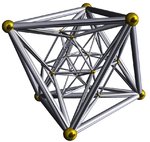
24-cell








Truncated 24-cell







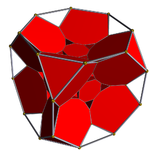
Bitruncated 24-cell







Schlegel diagrams centered on one [3,4] (cells at opposite at [4,3]) In geometry, a truncated 5-cell is a uniform polychoron (4-dimensional uniform polytope) formed as the truncation of the regular 5-cell.
There are two degrees of trunctions, including a bitruncation.
Contents
Truncated 5-cell
Truncated 24-cell Type Uniform polychoron Schläfli symbol t0,1{3,4,3}
t0,1,2{3,3,4}
t0,1,2,3{31,1,1}
Coxeter-Dynkin diagrams 


















Cells 48 24 4.6.6 
24 4.4.4
Faces 240 144 {4}
96 {6}Edges 384 Vertices 192 Vertex figure 


equilateral triangular pyramidSymmetry groups F4 [3,4,3]
B4 [3,3,4]
D4 [31,1,1]Properties convex zonohedron Uniform index 23 24 25 The truncated 24-cell is a uniform 4-dimensional polytope (or uniform polychoron), which is bounded by 48 cells: 24 cubes, and 24 truncated octahedra. Each vertex contains three truncated octahedra and one cube, in an equilateral triangular pyramid vertex figure.
Construction
The truncated 24-cell can be constructed from with three symmetry groups:
- F4 [3,4,3]: A truncation of the 24-cell.
- B4 [3,3,4]: A cantitruncation of the 16-cell, with two families of truncated octahedral cells.
- D4 [31,1,1]: An omnitruncation of the demitesseract, with three families of truncated octahedral cells.
It is also a zonotope: it can be formed as the Minkowski sum of the six line segments connecting opposite pairs among the twelve permutations of the vector (+1,−1,0,0).
Cartesian coordinates
The Cartesian coordinates of the vertices of a truncated 24-cell having edge length sqrt(2) are all coordinate permutations and sign combinations of:
- (0,1,2,3)
The dual configuation has coordinates at all coordinate permutation and signs of
- (1,1,1,5)
- (1,3,3,3)
- (2,2,2,4)
Structure
The 24 cubical cells are joined via their square faces to the truncated octahedra; and the 24 truncated octahedra are joined to each other via their hexagonal faces.
Projections
The parallel projection of the truncated 24-cell into 3-dimensional space, truncated octahedron first, has the following layout:
- The projection envelope is a great rhombicuboctahedron.
- Two of the truncated octahedra project onto a truncated octahedron lying in the center of the envelope.
- Six cuboidal volumes join the square faces of this central truncated octahedron to the center of the octagonal faces of the great rhombicuboctahedron. These are the images of 12 of the cubical cells, a pair of cells to each image.
- The 12 square faces of the great rhombicuboctahedron are the images of the remaining 12 cubes.
- The 6 octagonal faces of the great rhombicuboctahedron are the images of 6 of the truncated octahedra.
- The 8 (non-uniform) truncated octahedral volumes lying between the hexagonal faces of the projection envelope and the central truncated octahedron are the images of the remaining 16 truncated octahedra, a pair of cells to each image.
Images
orthographic projections Coxeter plane F4 Graph 
Dihedral symmetry [12] Coxeter plane B3 / A2 (a) B3 / A2 (b) Graph 
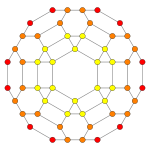
Dihedral symmetry [6] [6] Coxeter plane B4 B2 / A2 Graph 

Dihedral symmetry [8] [4] 
Schlegel diagram
(cubic cells visible)
Schlegel diagram
8 of 24 truncated octahedral cells visible
net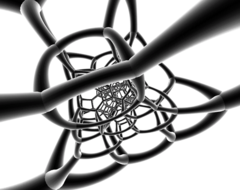
Stereographic projection
Centered on truncated tetrahedronBitruncated 24-cell
Bitruncated 24-cell 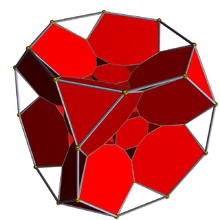
Schlegel diagram, centered on truncated cube, with alternate cells hiddenType Uniform polychoron Schläfli symbol t1,2{3,4,3} Coxeter-Dynkin diagram 






Cells 48 (3.8.8) 
Faces 336 192 {3}
144 {8}Edges 576 Vertices 288 Edge figure 3.8.8 Vertex figure 
tetragonal disphenoidSymmetry group F4, [[3,4,3]], order 2304 Properties convex, isogonal, isotoxal, isochoric Uniform index 26 27 28 The bitruncated 24-cell is a 4-dimensional uniform polytope (or uniform polychoron) derived from the 24-cell. It is constructed by bitruncating the 24-cell (truncating at halfway to the depth which would yield the dual 24-cell).
Being a uniform polychoron, it is vertex-transitive. In addition, it is cell-transitive, consisting of 48 truncated cubes, and also edge-transitive, with 3 truncated cubes cells per edge and with one triangle and two octagons around each edge.
The 48 cells of the bitruncated 24-cell correspond with the 24 cells and 24 vertices of the 24-cell. As such, the centers of the 48 cells form the root system of type F4.
Its vertex figure is a tetragonal disphenoid, a tetrahedron with 2 opposite edges length 1 and all 4 lateral edges length sqrt(2+sqrt(2)).
Alternative names
- Bitruncated 24-cell (Norman W. Johnson)
- 48-cell as a cell-transitive 4-polytope
- Bitruncated icositetrachoron
- Bitruncated polyoctahedron
- Tetracontaoctachoron (Cont) (Jonathan Bowers)
Structure
The truncated cubes are joined to each other via their octagonal faces in anti orientation; i. e., two adjoining truncated cubes are rotated 45 degrees relative to each other so that no two triangular faces share an edge.
The sequence of truncated cubes joined to each other via opposite octagonal faces form a cycle of 8. Each truncated cube belongs to 3 such cycles. On the other hand, the sequence of truncated cubes joined to each other via opposite triangular faces form a cycle of 6. Each truncated cube belongs to 4 such cycles.
Coordinates
The Cartesian coordinates of a bitruncated 24-cell having edge length 2 are all permutations of coordinates and sign of:
- (0, 2+√2, 2+√2, 2+2√2)
- (1, 1+√2, 1+√2, 3+2√2)
Projections
Projection to 2 dimensions
orthographic projections Coxeter plane F4 B4 Graph 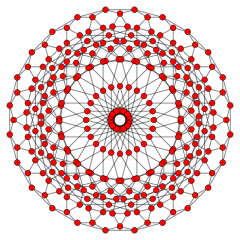
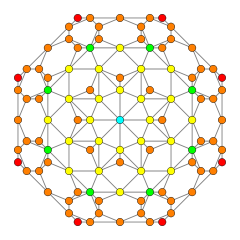
Dihedral symmetry [[12]] [8] Coxeter plane B3 / A2 B2 / A3 Graph 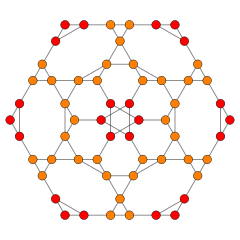

Dihedral symmetry [6] [[4]] Projection to 3 dimensions
Orthographic Perspective The following animation shows the orthographic projection of the bitruncated 24-cell into 3 dimensions. The animation itself is a perspective projection from the static 3D image into 2D, with rotation added to make its structure more apparent.

The images of the 48 truncated cubes are laid out as follows:- The central truncated cube is the cell closest to the 4D viewpoint, highlighted to make it easier to see. To reduce visual clutter, the vertices and edges that lie on this central truncated cube have been omitted.
- Surrounding this central truncated cube are 6 truncated cubes attached via the octagonal faces, and 8 truncated cubes attached via the triangular faces. These cells have been made transparent so that the central cell is visible.
- The 6 outer square faces of the projection envelope are the images of another 6 truncated cubes, and the 12 oblong octagonal faces of the projection envelope are the images of yet another 12 truncated cubes.
- The remaining cells have been culled because they lie on the far side the bitruncated 24-cell, and are obscured from the 4D viewpoint. These include the antipodal truncated cube, which would have projected to the same volume as the highlighted truncated cube, with 6 other truncated cubes surrounding it attached via octagonal faces, and 8 other truncated cubes surrounding it attached via triangular faces.
The following animation shows the cell-first perspective projection of the bitruncated 24-cell into 3 dimensions. Its structure is the same as the previous animation, except that there is some foreshortening due to the perspective projection.

Stereographic projection 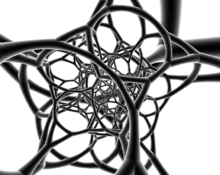
Related regular skew polyhedron
The regular skew polyhedron, {8,4|3}, exists in 4-space with 4 octagonal around each vertex, in a zig-zagging nonplanar vertex figure. These octagonal faces can be seen on the bitruncated 24-cell, using all 576 edges and 288 vertices. The 192 triangular faces of the bitruncated 24-cell can be seen as removed. The dual regular skew polyhedron, {4,8|3}, is similarly related to the square faces of the runcinated 24-cell.
Related polytopes
BC4:
Name tesseract rectified
tesseracttruncated
tesseractcantellated
tesseractruncinated
tesseractbitruncated
tesseractcantitruncated
tesseractruncitruncated
tesseractomnitruncated
tesseractCoxeter-Dynkin
diagram






























































Schläfli
symbol{4,3,3} t1{4,3,3} t0,1{4,3,3} t0,2{4,3,3} t0,3{4,3,3} t1,2{4,3,3} t0,1,2{4,3,3} t0,1,3{4,3,3} t0,1,2,3{4,3,3} Schlegel
diagram








B4 Coxeter plane graph 








Name 16-cell rectified
16-celltruncated
16-cellcantellated
16-cellruncinated
16-cellbitruncated
16-cellcantitruncated
16-cellruncitruncated
16-cellomnitruncated
16-cellCoxeter-Dynkin
diagram






























































Schläfli
symbol{3,3,4} t1{3,3,4} t0,1{3,3,4} t0,2{3,3,4} t0,3{3,3,4} t1,2{3,3,4} t0,1,2{3,3,4} t0,1,3{3,3,4} t0,1,2,3{3,3,4} Schlegel
diagram








B4 Coxeter plane graph 








F4:
Name 24-cell truncated 24-cell rectified 24-cell cantellated 24-cell bitruncated 24-cell cantitruncated 24-cell runcinated 24-cell runcitruncated 24-cell omnitruncated 24-cell snub 24-cell Schläfli
symbol{3,4,3} t0,1{3,4,3} t1{3,4,3} t0,2{3,4,3} t1,2{3,4,3} t0,1,2{3,4,3} t0,3{3,4,3} t0,1,3{3,4,3} t0,1,2,3{3,4,3} h0,1{3,4,3} Coxeter-Dynkin
diagram





































































Schlegel
diagram









F4 









B4 









B3(a) 









B3(b) 





B2 









External links
- 3. Convex uniform polychora based on the icositetrachoron (24-cell) - Model 24, 27, George Olshevsky.
- Richard Klitzing, 4D, uniform polytopes (polychora) x3x4o3o - tico, o3x4x3o - cont
Categories:- Four-dimensional geometry
- Polychora
Wikimedia Foundation. 2010.
